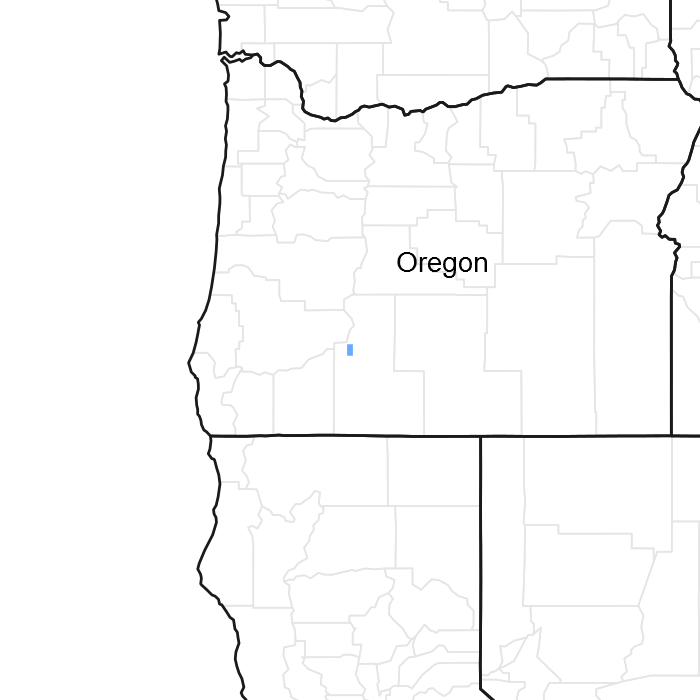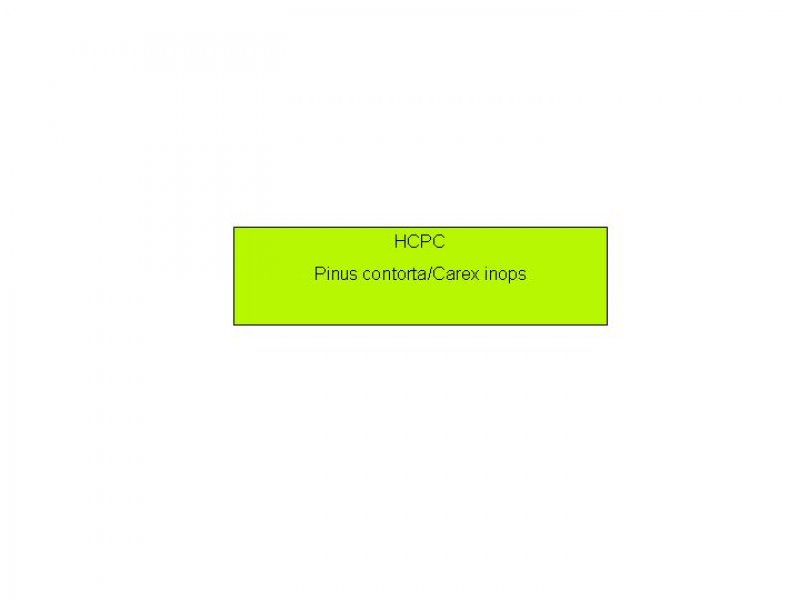
Natural Resources
Conservation Service
Ecological site F006XY704OR
East Crater Lake Pumice Basins
Accessed: 12/19/2025
General information
Provisional. A provisional ecological site description has undergone quality control and quality assurance review. It contains a working state and transition model and enough information to identify the ecological site.

Figure 1. Mapped extent
Areas shown in blue indicate the maximum mapped extent of this ecological site. Other ecological sites likely occur within the highlighted areas. It is also possible for this ecological site to occur outside of highlighted areas if detailed soil survey has not been completed or recently updated.
Table 1. Dominant plant species
| Tree |
(1) Pinus contorta |
|---|---|
| Shrub |
Not specified |
| Herbaceous |
(1) Carex inops |
Physiographic features
This site is found on well drained, deep soils; on flat to gentle sloping landscapes that developed from volcanic ash flows.
Table 2. Representative physiographic features
| Landforms |
(1)
Ash flow
|
|---|---|
| Flooding frequency | None |
| Ponding frequency | None |
| Elevation | 4,000 – 6,000 ft |
| Slope | 7% |
| Water table depth | 60 in |
| Aspect | Aspect is not a significant factor |
Climatic features
Precipitation occurs mostly in the fall winter and spring . Much of it occurs as snow. Some rain can occur in the summer due to thunder storms. Winters are cold and wet and summers are warm and dry.
Table 3. Representative climatic features
| Frost-free period (average) | 60 days |
|---|---|
| Freeze-free period (average) | 90 days |
| Precipitation total (average) | 40 in |
Figure 2. Monthly precipitation range
Figure 3. Monthly average minimum and maximum temperature
Influencing water features
None
Soil features
This site is found on soils developed in volcanic ash flows deposits in valleys.
Table 4. Representative soil features
| Surface texture |
(1) Very gravelly loamy sand (2) Ashy loamy sand |
|---|---|
| Family particle size |
(1) Sandy |
| Drainage class | Somewhat excessively drained to excessively drained |
| Permeability class | Rapid to very rapid |
| Soil depth | 60 in |
| Surface fragment cover <=3" | 10 – 50% |
| Surface fragment cover >3" | 20% |
| Available water capacity (0-40in) |
3.9 – 7.1 in |
| Calcium carbonate equivalent (0-40in) |
Not specified |
| Electrical conductivity (0-40in) |
Not specified |
| Sodium adsorption ratio (0-40in) |
Not specified |
| Soil reaction (1:1 water) (0-40in) |
6.1 – 7.3 |
| Subsurface fragment volume <=3" (Depth not specified) |
15 – 50% |
| Subsurface fragment volume >3" (Depth not specified) |
25% |
Ecological dynamics
Lodgepole pine is the only tree specie in the overstory of the historic climax plant community. The position of this site, flat basins, is influenced by cold air drainage which affects tree seedling survival. Lodgepole pine seedlings are the only ones that have adapted to these conditions.
Heavy to very heavily stocked stands are susceptible to mountain pine beetle infestations. If an outbreak occurs all lodgepole can be killed. If seedlings are present then a new stand will start. Large areas killed may take many years to return to a lodgepole forest. Planting seedlings will quicken the successional process.
State and transition model

More interactive model formats are also available.
View Interactive Models
More interactive model formats are also available.
View Interactive Models
Click on state and transition labels to scroll to the respective text
Ecosystem states
State 1 submodel, plant communities
State 1
Lodgepole Pine
Community 1.1
Lodgepole Pine
The Lodgepole pine plant community is the historic climax plant community. Understory ground cover is low, generally under 30 per cent. The specie mix is also low. Carex dominates the specie composition with small and very small amounts of other species. Three or more Carex species are present.
Forest overstory. The typical overstory composition of the Lodgepole pine plant community.
Forest understory. The typical annual production of the understory species to a height of 4.5 feet (excluding boles of trees) under low, high, and representative canopy covers.
Plant composition is expressed as "percent canopy cover". Species listed as "0" percent are present at less than 1 percent canopy cover.
Table 5. Ground cover
| Tree foliar cover | 20-30% |
|---|---|
| Shrub/vine/liana foliar cover | 3-5% |
| Grass/grasslike foliar cover | 15-20% |
| Forb foliar cover | 0-1% |
| Non-vascular plants | 0% |
| Biological crusts | 0% |
| Litter | 25-35% |
| Surface fragments >0.25" and <=3" | 1-3% |
| Surface fragments >3" | 1-2% |
| Bedrock | 0% |
| Water | 0% |
| Bare ground | 8-12% |
Table 6. Soil surface cover
| Tree basal cover | 0% |
|---|---|
| Shrub/vine/liana basal cover | 0% |
| Grass/grasslike basal cover | 0-3% |
| Forb basal cover | 0-1% |
| Non-vascular plants | 0% |
| Biological crusts | 0% |
| Litter | 50-60% |
| Surface fragments >0.25" and <=3" | 1-5% |
| Surface fragments >3" | 1-2% |
| Bedrock | 0% |
| Water | 0% |
| Bare ground | 15-20% |
Table 7. Canopy structure (% cover)
| Height Above Ground (ft) | Tree | Shrub/Vine | Grass/ Grasslike |
Forb |
|---|---|---|---|---|
| <0.5 | – | 0-1% | 3-5% | – |
| >0.5 <= 1 | – | – | 15-20% | – |
| >1 <= 2 | – | – | – | – |
| >2 <= 4.5 | – | 1-3% | – | – |
| >4.5 <= 13 | 1-2% | – | – | – |
| >13 <= 40 | 3-5% | – | – | – |
| >40 <= 80 | 30-35% | – | – | – |
| >80 <= 120 | – | – | – | – |
| >120 | – | – | – | – |
Additional community tables
Interpretations
Recreational uses
Limited to hiking and camping
Wood products
Fire wood, Poles, Sawtimber,
Supporting information
Contributors
Craig Ziegler
Rangeland health reference sheet
Interpreting Indicators of Rangeland Health is a qualitative assessment protocol used to determine ecosystem condition based on benchmark characteristics described in the Reference Sheet. A suite of 17 (or more) indicators are typically considered in an assessment. The ecological site(s) representative of an assessment location must be known prior to applying the protocol and must be verified based on soils and climate. Current plant community cannot be used to identify the ecological site.
| Author(s)/participant(s) | |
|---|---|
| Contact for lead author | |
| Date | |
| Approved by | |
| Approval date | |
| Composition (Indicators 10 and 12) based on | Annual Production |
Indicators
-
Number and extent of rills:
-
Presence of water flow patterns:
-
Number and height of erosional pedestals or terracettes:
-
Bare ground from Ecological Site Description or other studies (rock, litter, lichen, moss, plant canopy are not bare ground):
-
Number of gullies and erosion associated with gullies:
-
Extent of wind scoured, blowouts and/or depositional areas:
-
Amount of litter movement (describe size and distance expected to travel):
-
Soil surface (top few mm) resistance to erosion (stability values are averages - most sites will show a range of values):
-
Soil surface structure and SOM content (include type of structure and A-horizon color and thickness):
-
Effect of community phase composition (relative proportion of different functional groups) and spatial distribution on infiltration and runoff:
-
Presence and thickness of compaction layer (usually none; describe soil profile features which may be mistaken for compaction on this site):
-
Functional/Structural Groups (list in order of descending dominance by above-ground annual-production or live foliar cover using symbols: >>, >, = to indicate much greater than, greater than, and equal to):
Dominant:
Sub-dominant:
Other:
Additional:
-
Amount of plant mortality and decadence (include which functional groups are expected to show mortality or decadence):
-
Average percent litter cover (%) and depth ( in):
-
Expected annual annual-production (this is TOTAL above-ground annual-production, not just forage annual-production):
-
Potential invasive (including noxious) species (native and non-native). List species which BOTH characterize degraded states and have the potential to become a dominant or co-dominant species on the ecological site if their future establishment and growth is not actively controlled by management interventions. Species that become dominant for only one to several years (e.g., short-term response to drought or wildfire) are not invasive plants. Note that unlike other indicators, we are describing what is NOT expected in the reference state for the ecological site:
-
Perennial plant reproductive capability:
Print Options
Sections
Font
Other
The Ecosystem Dynamics Interpretive Tool is an information system framework developed by the USDA-ARS Jornada Experimental Range, USDA Natural Resources Conservation Service, and New Mexico State University.
Click on box and path labels to scroll to the respective text.